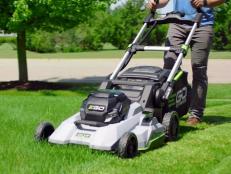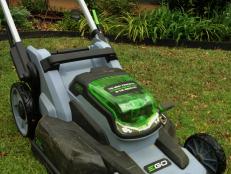The History of the Lawn Mower

Image courtesy of Felder Rushing

Most of us take our lawn mowers—and lawns, for that matter—for granted. But while the lawn has been around awhile as a garden concept, the mower is a totally modern invention.
Before I go any farther, a disclaimer: As a kid, I resented mowing the lawn and vowed to not have one when I grew up. And I made good on that vow by not having a personal lawn to this day. Even though I am an overtrained turf specialist with over three decades of consulting with both golf course managers and home gardeners who love their lawns, there is not one blade of turfgrass to be found in my own garden, except for a little patch in a pot, which I keep watered, trimmed, fertilized, and weeded—sort of a horticulturist’s version of a pet goldfish in a bowl.
Don’t get me wrong—I love lawns! But because I live overseas part of the year and am traveling most of the rest of the time, I have designed my little cottage garden with wide, overstuffed shrub and flower beds, generous decks, wide paths, and plants that don’t need regular attention while I am gone—or while I’m home, for that matter.
Besides, though there’s nothing like that feeling of accomplishment in a job well done, making up my bed each morning gives me the same satisfaction and pride my friends get from having finished mowing and edging their lawns.
Why We Do It
Humans love open spaces for a variety of reasons, especially if covered with something low growing that keeps things from being dusty in the summer and muddy in the winter. And groundcovers also keep the area remarkably cooler during hot weather—up to thirty degrees cooler than concrete, and fifteen degrees cooler than bare dirt.
Whether used as wall-to-wall carpeting or just an attractive throw rug patch, a lawn is a magnificent addition to nearly any landscape. It highlights and visually ties the garden together as a unifying element, and provides a space for birds and butterflies to swoop. Plus it’s a great place to set up a badminton net or hold a garden party, or to just lay on your back and watch the clouds go by.
And, truth be told, in spite of its terrific costs in time, equipment, energy, water fertilizer, pesticides, and sweat, it is far easier to strap yourself onto a mower and cut back and forth than to, say, keep a flower bed planted, mulched, and weeded.
Still, if you aren’t regular with the mowing, a lawn will quickly turn into a jumble of pest-laden weeds, wildflowers and woodlands.
Before Mowers
Up until just a few generations ago, most people had meadows that were cut two or three times a year at the most. They used “Grim Reaper” type scythes, which were long, narrow, sharp blades attached to long wooden handles. A good scythesman could easily cut a grassy meadow down to about an inch high, which is comparable to what a lawn mower can do; each had his scythe handle custom-made to his height; to cut higher, he adjusted his height by adding material to the soles of his boots.
Before string trimmers, for coarser areas we used a “swing blade” with its double edged serrated blade attached to a short-handled bowed yoke and swung back and forth in a wide arc. Not to be confused with a “Kaiser” or hook blade, which was long and wider and heavier with a hook on one side, used for cutting heavier brush and limbs.
First Mower
I made a pilgrimage to the Mecca of lawns—the British Lawnmower Museum in Southport, England, and was amazed at how simple early models were.
When in the late 1820s Edwin Budding of Gloucester, England, first started tinkering with a machine originally designed to cut knap from new cloth, he was considered a madman of sorts and had to experiment at night. His was a one-man contraption which looks surprisingly like a modern pushmower with its forward-rotating reel of cutting blades.
Soon larger, horse-drawn versions—the first riding mowers—were introduced. Steam powered mowers came about in the 1890s, and by 1920 gas powered mowers had made it to America.
When I was a kid, I actually used an antique gas-powered reel mower, an ungainly heavy machine found in my grandfather’s tool shed. Didn’t take long for us to dismantle it and use the smoke-belching engine for a homemade go-kart. Besides, it had been made obsolete by modern “rotary” mowers like most home gardeners in America use today, made practical in the 1940s by lightweight, efficient, and inexpensive gas engines.
Rotary mowers are important because, with the exception of golf courses and other athletic fields and winter lawns, most of our Southern turf grasses, especially coarse-textured St.Augustine or centipede, are hard to cut with a reel mower, which is better on fine-textured Bermuda, zoysia, and rye grass and fescue.
Anyway, the museum visit helped me pay homage to the lawn mower and get a close look at many dozens of mowers, from examples of Budding’s first mowers to gas-powered scythes, wheel-less “hover” mowers, robotic mowers and early string trimmers.
Today there is a clear trend towards smaller, more manageable and more attractive lawns, using more efficient electric mowers that don’t require loud, energy-hog gas engines. And towards simple, efficient push mowers, much like the earliest mowers except made of strong but lightweight materials.
For better or worse, Budding made the lawn do-able for everyone. His mower, in all its incarnations, has made lawn care easier, forever changing our home gardens and landscapes, city parks, athletic fields and roadsides which are safer to pull over onto in case of emergency.
And in addition to giving us a little regular exercise, it helps neighbors think we actually care about something other than just making our beds.













































